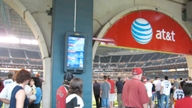Outdoor sports advertising shows growth potential

To most people, the timing couldn’t be worse to sell advertising on television, especially for a start-up company without a major reputation. But Arena Media Networks (AMN) of New York is doing just that — and growing.
With only 25 employees, AMN, founded in 2003, is bucking the ad sales trend by mining a narrow niche on video displays carrying live feeds in sports venues. It’s now in about 50 professional sports arenas and stadiums, including Yankee Stadium, Wrigley Field, the United Center in Chicago, Dodger Stadium and Madison Square Garden.
AMN sells ads on displays that usually carry the live game going on a few feet away from the viewer. Every day, its Manhattan-based programmers insert dozens of 30-second spots into live game feeds. Those feeds then play on TV screens located near concession stands, in luxury suites or in team stores.
AMN, which makes a deal with the individual teams, allows advertisers to purchase time in as many arenas and stadiums as they want. The spots can be broadcast as often as the client wants, whether before, during and/or after games. During the actual game, the ads are played during time-outs, intermissions and at half times.
Advertisers have the advantage of knowing who watches their ads in sports venues. Usually the viewers are men, passionate sports fans and consumers with disposable income — a very desirable group for advertisers.
AMN pays the owner of the sports arena a fee to broadcast over its displays and shares a percentage of the revenue it earns from advertisers. So far, those advertisers include companies such as Ford, Geico Insurance and the U.S. Army.
AMN also offers stadium owners an IP-based digital signage network that offers customized real-time team statistics intermingled with starting lineups and team trivia. The digital network offers different levels of interactivity from simple text messaging to Bluetooth transmissions.
Get the TV Tech Newsletter
The professional video industry's #1 source for news, trends and product and tech information. Sign up below.
Though AMN officials have not revealed specific statistics, the company said its revenue has grown 50 percent in each of the past three years, and it expects to break even in 2009. In the past two years, AMN has doubled the number of arenas where it does broadcasts, and the company’s goal is 100 major league venues. It will then move into college sports.
Because newer stadiums also have more TV screens than ever, opportunities are widening for AMN. CitiField, the new home of the New York Mets, will have more than 700 TV screens, including three in each suite. AMN has a contract for all the screens.
AMN’s success is perhaps due to its niche. Because its advertising is outside of the home, it’s considered outdoor advertising. Unlike ads for media inside the home, such alternative ads for venues like the back seats of taxis, on gas pumps and in shopping malls has grown steadily. Outdoor advertising grew 8.9 percent in 2005, 11.2 percent in 2006 and 2.3 percent in 2007, according to Nielsen Media Research.
AMN’s business is so new that few know how to predict its future. But in addition to the upgrading of sports technology in new sports arenas, the young company has another very key advantage. Currently, it has no competition.
